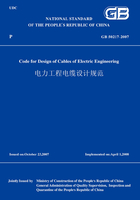
3.3 Cable Insulation Level
3.3.1 The rated phase-to-phase voltage of power cable conductor in an AC system shall not be lower than the working line voltage of the circuit in which it is used.
3.3.2 The selection of the rated voltage between the power cable's core and the insulation shielding or the metal sheath in an AC system shall comply with the following requirements:
1 In systems where neutral-point is grounded solidly or through low resistance,at least 100% of the working phase voltage of the circuit shall be used if the fault is cleared within one minute.
2 The power supply systems other than that described in Item 1 should not use the voltage less than 133% of the circuit's working phase voltage;173% of the circuit's working phase voltage should be used when a single-phase-to-ground fault may last for more than 8 hours or high security is required in the generator circuit.
3.3.3 The withstand voltage level of cables in AC systems shall meet the requirements on insulation coordination of the system.
3.3.4 The insulation level of DC transmission cables shall be able to withstand voltage tests by application of impulse voltage superimposed on DC voltage with reversal of direction with polarity,and the XLPE cables shall be able to suppress space charge accumulation and to avoid local high field strength suitable for the operation of DC electric field.
3.3.5 The rated voltage of control cables shall be selected to be not lower than the working voltage of the circuit and meet the following requirements:
1 The rated voltage of control cables(pilot cables)laid in parallel with HV cables shall meet the requirements for this arrangement.
2 The rated voltage of control cables for HV distribution devices of 220kV or above shall be 450/750V.
3 In other cases,the rated voltage of control cables should be 450/750 V and may be lower if the external electrical interference is less.